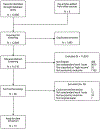Describing economic benefits and costs of nonstandard work hours: A scoping review
- PMID: 34687049
- PMCID: PMC9023590
- DOI: 10.1002/ajim.23302
Describing economic benefits and costs of nonstandard work hours: A scoping review
Abstract
Background: The benefits of nonstandard work hours include increased production time and the number of jobs. While for some sectors, such as emergency services, around-the-clock work is a necessary and critical societal obligation, work outside of traditional daytime schedules has been associated with many occupational safety and health hazards and their associated costs. Thus, organizational- and policy-level decisions on nonstandard work hours can be difficult and are based on several factors including economic evaluation. However, there is a lack of systematic knowledge of economic benefits and costs associated with these schedules.
Methods: We conducted a scoping review of the methodology and data used to examine the economic benefits and costs of nonstandard work hours and related interventions to mitigate risks.
Results: Ten studies met all our inclusion criteria. Most studies used aggregation and analysis of national and other large datasets. Costs estimated include health-related expenses, productivity losses, and projections of future loss of earnings. Cost analyses of interventions were provided for an obstructive sleep apnea screening program, implementation of an employer-based educational program, and increased staffing to cover overtime hours.
Conclusions: A paucity of studies assess nonstandard work hours using economic terms. Future studies are needed to expand economic evaluations beyond the employer level to include those at the societal level because impacts of nonstandard work go beyond the workplace and are important for policy analysis and formulation. We pose the opportunity for researchers and employers to share data and resources in the development of more analyses that fill these research gaps.
Keywords: economic benefits; economic costs; economic evaluation; long work hours; nonstandard shifts; scoping review; shift work.
© 2021 Wiley Periodicals LLC.
Conflict of interest statement
CONFLICTS OF INTEREST
The authors declare that there are no conflicts of interest.
DISCLOSURE BY AJIM EDITOR OF RECORD
John Meyer declares that he has no conflict of interest in the review and publication decision regarding this article.
References
-
- National Center for Health Statistics. National Health Interview Survey, 2015. Public-use data file and documentation. Accessed November 2019. https://www.cdc.gov/nchs/nhis/nhis_2015_data_release.htm
-
- Sloane P Economic aspects of shift and night work in industrialized market economies. Int Lab Rev 1978:117–129.
-
- NIOSH. NIOSH training for nurses on shift work and long work hours: benefits of shift work and long work hours. US Department of Health and Human Services, Centers for Disease Control and Prevention, National Institute for Occupational Safety and Health, DHHS (NIOSH) Publication No. 2015-115 (Revised 04/2020). 2020. Accessed September 2021. https://www.cdc.gov/niosh/work-hour-training-for-nurses/longhours/mod1/0...
-
- Kim M Who works nonstandard schedules voluntarily?: the role of having children. J Fam Stud. 2020;29:1–8.
-
- International Agency for Research on Cancer. Night shift work: IARC monographs on the identification of carcinogenic hazards to humans, Vol. 124. 2020. https://publications.iarc.fr/593 - PubMed
Publication types
MeSH terms
Grants and funding
LinkOut - more resources
Full Text Sources
Miscellaneous


